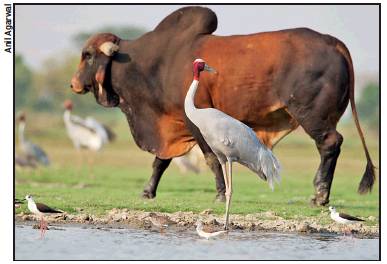Bharatpur: Keoladeo National Park (bird sanctuary)
This is a collection of articles archived for the excellence of their content. |
Cattle
2019: Abandoned cattle overrun sanctuary
Anuja Jaiswal, March 7, 2019: The Times of India

From: Anuja Jaiswal, March 7, 2019: The Times of India
At Rajasthan’s Keoladeo National Park, the Unesco world heritage site formerly known as Bharatpur bird sanctuary, tourists arrive from across the country and abroad to see hundreds of species of birds, including migratory ones, for which the protected forest is famous. These days, however, they are treated to the sight of masses of stray cows and bulls, abandoned inside the forest by neighbouring villagers. Park authorities are now planning to raise the height of the boundary wall to 10 feet to prevent this incursion.
“It is shocking to see so many cows and bulls at a place which is touted as one of the best bird-watching sites in Asia. The government must do something to control this problem. People visit Keoladeo to watch birds in their natural habitat, not cattle,” said Anupama Bisht, a tourist who had come to the sanctuary with her friends.
Bird watchers and ecologists fear that the presence of a large number of stray cattle could drive away the migratory birds, which are a major attraction in the sanctuary.
Sanctuary home to over 375 avian species
Admitting that stray cattle have become a problem in the sanctuary, Bharatpur deputy conservator of forests (wildlife) Ajit Uchoi said, “I have submitted a project estimate of Rs 3 to 5 crore for raising the height of the park’s boundary wall. The current height of the boundary wall is 7 feet, but there are several places where it is very low because of the undulating landscape. These are the spots through which villagers bring the animals in. If the height is raised to 10 feet throughout, this problem will be solved.”
Three years before Unesco declared it a World Heritage Site in 1985, the Union government had banned grazing in the protected area. Uchoi said residents of nearby villages — Aghapur, Mala, Jatoli and Barso — usually bring cattle on trucks or tractor-trolleys late at night and let them loose inside the forest.
So far, forest officials have transported nearly 200 heads of cattle from the protected area to the ravines of Chambal, nearly 80-100 km away. “The presence of cattle in such large numbers can certainly disturb birds. In such a situation, the migratory birds will move away elsewhere. This could then affect the arrival of migratory birds in winters,” said ecologist, conservationist and Asian Waterbird Census Delhi state coordinator TK Roy.
The bird sanctuary is home to over 375 avian species, of which more than 100 are migratory — including the northern shoveler, pintail, common coot, painted stork and shag — and arrive in winter. The park also has fairly stable populations of deer, nilgai, sambhar, hyena, jungle cat, jackal, civet and wild boar.